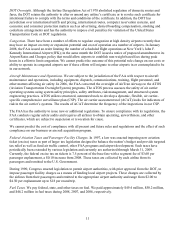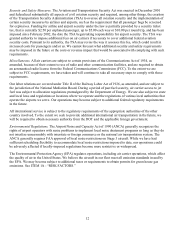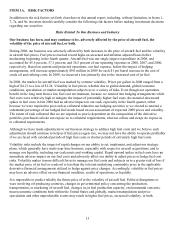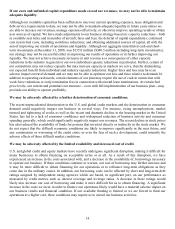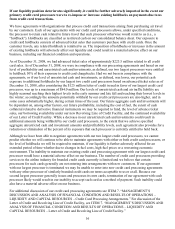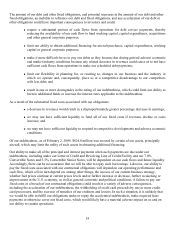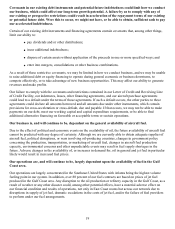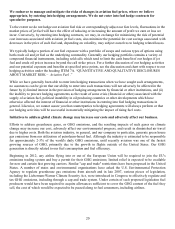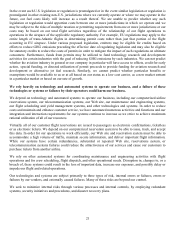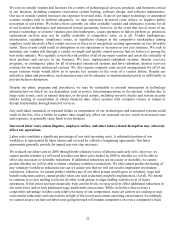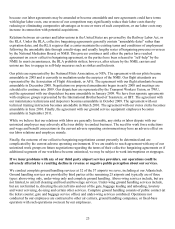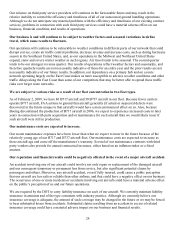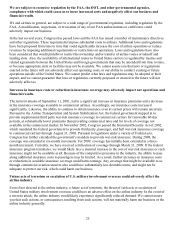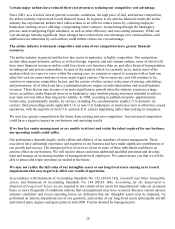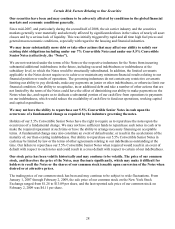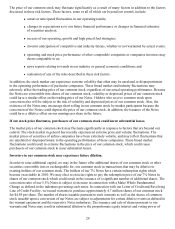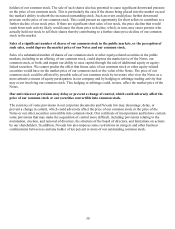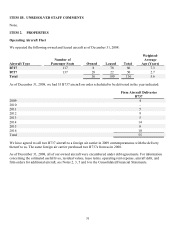Airtran 2008 Annual Report Download - page 29
Download and view the complete annual report
Please find page 29 of the 2008 Airtran annual report below. You can navigate through the pages in the report by either clicking on the pages listed below, or by using the keyword search tool below to find specific information within the annual report.In the event such U.S. legislation or regulation is promulgated or in the event similar legislation or regulation is
promulgated in other existing non-U.S. jurisdictions where we currently operate or where we may operate in the
future, our fuel costs likely will increase as a result thereof. We are unable to predict whether any such
legislation or regulation would apportion costs between one or more jurisdictions in which we operate and we
may be subject to the risks of multiple taxation or permitting requirements from one or more jurisdictions or our
costs may be based on our total flight activities regardless of the relationship of our flight operations to
operations in the airspace of the applicable regulatory authority. For example, EU regulations may apply to the
entire length of trans-Atlantic flights in determining permit costs rather than just that portion of the flight
occurring in EU airspace. Under various proposed legislation, emitters may be eligible for credits based on
efforts to reduce GHG emissions preceding the effective date of regulating legislation and may also be eligible
for statutory credits to reduce the costs of permits in order to mitigate the impact of such regulations on ultimate
consumers. Furthermore, funds from permits may be utilized to fund technology research and development
activities for certain industries with the goal of reducing GHG emissions by such industries. We can not predict
whether the aviation industry in general or our company in particular will have access to offsets, credit for early
action, special funding, or directed utilization of permit proceeds to provide funding for aviation research and
development or alternative jet fuel research. Similarly, we cannot predict whether particular benefits or
exemptions would be available to us or at all based on our status as a low cost carrier, as a new market entrant
in a particular market or based on our rate of growth.
We rely heavily on technology and automated systems to operate our business, and a failure of these
technologies or systems or failures by their operators could harm our business.
We depend on technology and automated systems to operate our business, including our computerized airline
reservations system, our telecommunication systems, our Web site, our maintenance and engineering systems,
our flight scheduling and yield management systems, and other technologies and systems. In order to reduce
costs and maintain and enhance customer service, we have automated numerous activities and functions and our
integration and interaction requirements for our systems continue to increase as we strive to achieve maximum
rational utilization of all of our resources.
Virtually all of our customer flight reservations are issued to passengers as electronic confirmations, ticketless
or as electronic tickets. We depend on our computerized reservation system to be able to issue, track, and accept
this data. In order for our operations to work efficiently, our Web site and reservation system must be able to
accommodate a high volume of traffic, maintain secure information, and deliver important flight information.
While our systems have certain redundancies, substantial or repeated Web site, reservations system, or
telecommunication systems failures could reduce the attractiveness of our services and cause our customers to
purchase tickets from another airline.
We rely on other automated systems for coordinating maintenance and engineering activities with flight
operations and for crew scheduling, flight dispatch, and other operational needs. Disruption in, changes to, or a
breach of, these systems could result in the loss of important data, increase our expenses, and possibly delay or
impede our flight and related operations.
Our technologies and systems are subject primarily to three types of risk, internal errors or failures, errors or
failures by our vendors, and externally caused failures. Many of these risks are beyond our control.
We seek to minimize internal risks through various processes and internal controls, by employing redundant
systems, security initiatives and procedures, and disaster recovery plans.
21


